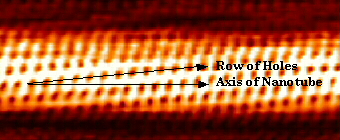Nanotubes: Metallic by a twist of fate
(This story appeared on page 22 of the
Jan. 10, 1998, Science News.)
By Sid Perkins
Science News
When a tailor mismatches the stripes in a fabric while sewing a shirt, the garment merely looks funny. However, when a single atomic layer of graphite rolls up into the minuscule cylinder known as a nanotube, the angle at which the edges join can have a dramatic effect upon the tube's electrical conductivity.
Even though they are made of exactly the same material, some carbon nanotubes conduct electricity as easily as a metal does, while others act as semiconductors, blocking the passage of low-voltage current. This property, first predicted by three research groups in 1992, has now been observed by two teams of scientists, one from Harvard university and the other from Rice University in Houston and Delft University of Technology in the Netherlands. Their findings appear in the Jan. 1 NATURE.
Both teams used a scanning tunneling microscope to determine the diameter and spiral angle of a nanotube. They then measured the tube's conductivity with a miniature probe.
"It's remarkable how one small change in a nanotube's structure can make a tremendous difference in its electrical behavior," says Andrew G. Rinzler of Rice.
In graphite, each carbon atom links to three others, forming a hexagonal lattice that resembles a slice through an atomic-scale honeycomb. The regularity of this pattern allows the edges of the sheet of graphite, when rolled into a cylinder, to match seamlessly at several different angles.
"This landmark work goes a long way toward telling us that the basic theory is correct," says Mildred S. Dresselhaus, a physicist at the Massachusetts Institute of Technology. However, she adds, additional experimental and theoretical work needs to be done to link some of the teams' observations to the details of the theory.



 Photo Credit: Delft University of Technology
Photo Credit: Delft University of Technology
The wrapping angle between the axis of the carbon nanotube (solid arrow) and the row of holes in the graphite's hexagonal lattice (dotted arrow) affects the nanotube's electric conductivity.



---[
Copyright 1998 by Science Service.
All rights reserved.
---[









